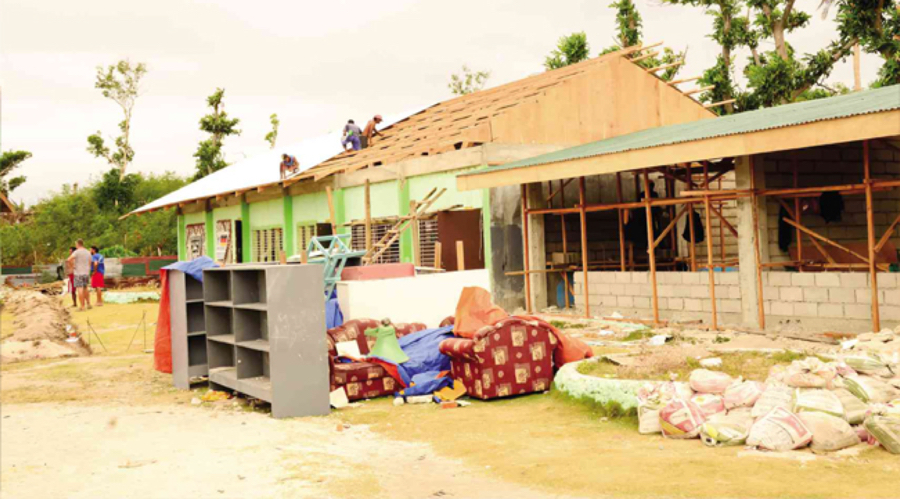
A year after super typhoon Yolanda (international name: Haiyan) ravaged Central Philippines, Valenzuela City Congressman Win Gatchalian lauded the private sector for spearheading the construction and rehabilitation of a sizeable number of classrooms in areas damaged by the typhoon.
To date, some 375 permanent classrooms have been built or undergoing construction through the efforts of private firms, foundations, local and international non-government groups, and individuals since typhoon Yolanda hit the Philippines in November 8 last year, based on the data received last Friday from the Office of the Presidential Assistant for Rehabilitation and Recovery (OPARR).
There are also 444 classrooms already repaired or being fixed via the efforts of the private sector, according to OPARR.
Oparr said deliverables in social infrastructure from the private sector include 19,648 classrooms and 28 school buildings which are expected to be all completed by 2016.
“The private sector deserves an accolade for taking the initiatives in constructing new classrooms and rebuilding damaged ones. They are the saving grace in the education infrastructure and they set an example that should be followed by concerned government agencies,” said Gatchalian, a majority member for the House committees on basic education and culture and on higher and technical education.
Gatchalian warned that the longer it takes for classrooms to be built or repaired in the areas struck by super typhoon Yolanda, the more children will stop studying and add to the growing number of people living in poverty.
“Various studies have shown that children tend to quit schooling if they feel that their classroom is not conducive to learning. You can just imagine children in Yolanda-devastated areas using tents for their classroom for almost a year and longing for the repair of their damaged schools so they can study well,” said Gatchalian, a stalwart of the Nationalist People’s Coalition (NPC).
A report of Save the Children, a children’s rights organization, released last February showed that Eastern Visayas posted an 8-percent pre-disaster school leaver rate for both public and private elementary schools, higher than the 2.9-percent national average.
In 2012, Eastern Samar had poverty incidence at 63.7%, Northern Samar at 50.2%, Negros Oriental at 50.1%, and Western Samar at 50%.
Close to 3,000 public school classrooms were totally destroyed by super typhoon Yolanda a year ago and unfortunately, less than 5 percent of the destroyed classrooms have been reconstructed, while 5 percent of more than 17,000 damaged classrooms have been fully repaired, the Department of Education or DepEd has reported.
It was stated in the same DepEd report that less than 30 percent of the more than 290,000 school furniture destroyed during the super typhoon have been procured, but none of the 6.47 million lost learning materials have been replaced.
Reporting the status of the rehabilitation of 2,990 schools affected by super typhoon Yolanda, Education Secretary Armin Luistro said the DepEd is aiming to complete the classroom reconstruction in time for the start of the next school year in June.
The apparent slowness of the DepEd in infrastructure could be seen in the very data released by the agency, wherein only 101 of the 2,313 new classrooms to be constructed have been completed by the DepEd based on an accomplishment report dated November 3.
Of the remaining number, only 212 are in the stage of “ongoing construction/delivery” while others are still under procurement, re-assessment, and validation, or have just been pledged by private partners.
“It will be a tall order for the DepEd to finish the rehabilitation of 2,990 schools affected by super typhoon Yolanda. We hope that their targets will be met for the sake of the affected schoolchildren who continue to hold classes in tents,” said Gatchalian.
A situation report by the United Nations Children’s Fund (UNICEF) dated October 10 posted an even larger figure of 1,706 classrooms “made usable through makeshift and temporary repairs”. UNICEF also provided 2,132 tents as temporary learning spaces.
The DepEd, on the other hand, has repaired only 833 of the 17,335 damaged classrooms, of which nearly 600 were financed through donations from both foreign and local donors, including the Philippine Amusement and Gaming Corporation (Pagcor).
The biggest DepEd project in the category, defrayed by a 2013 Quick Response Fund worth P3.043 billion, is still under re-assessment and validation. It covers 10,581 classrooms.
The DepEd accomplishment report also showed that only 27% of the projected 292,166 school furniture have been completed.
Based on news reports, P2.58 billion has been allocated for new classrooms and P2.24 billion for classroom repairs this year.
Next year, the respective budgets for the construction of 331 more new classrooms and rehabilitation of 10,711 damaged classrooms are P331 million and P2.4 billion.
Based on figures reported by the UN Office for the Coordination of Humanitarian Affairs (OCHA) last January, 5.92 million of the 14.1 million super typhoon Yolanda-affected population are children aged under 18.The disaster also displaced 4.1 million people, including 1.7 million children. (Monica Cantilero)


